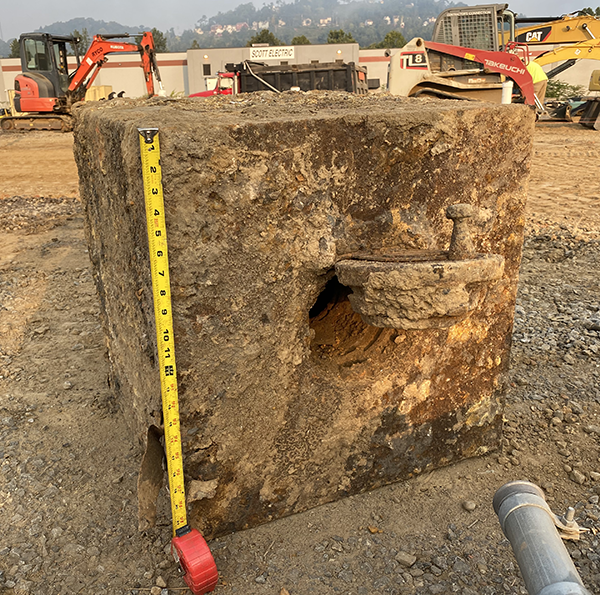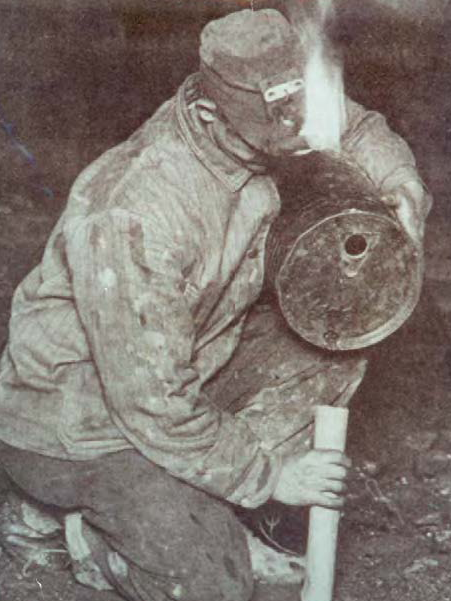Mining Feature: Digging up relics of the Mining Program's Past
Monday, May 17, 2021

A construction crew discovered a historic blast safe in Pittsburgh's Lawrenceville neighborhood. (Click for larger image.)
The NIOSH mining program was recently reunited with relics from its beginning more than a century ago.
Construction workers digging foundations for a multi-use development in Pittsburgh unearthed mysterious relics from the site’s past. With the help of an archeological consultant, the relics were traced to a government laboratory that is historically linked to the current NIOSH Program. Current NIOSH researchers and the consultant solved the mystery and identified the relics as a blast testing safe and other test apparatus.
The blast testing safe dates back to the period when a mining research unit was created, first as a technologic research branch of the U.S. Geological Survey in 1904, and then more formally on July 1, 1910, as the U.S. Bureau of Mines (USBM). Later (1996), the USBM health and safety research was transferred to NIOSH, where it continues to research safety and health solutions to this day.
The Lawrenceville location where the relics were found once housed the Allegheny Arsenal, a sprawling munitions production and supply operation of the U.S. War Department. As the arsenal’s operations were winding down in the early 1900s, some of the vacated space was set aside for the fledgling mining research branch. Research continued there from 1908 to 1917, then moved to new laboratories in the city’s Oakland neighborhood and the Bruceton Research Center outside of the city, apparently leaving some traces to be unearthed later.

A miner fills a cartridge for blasting. Note the open flame from the miner's cap lamp. (Click for larger image.)
Blast testing safes like the one found at the Lawrenceville site were used to measure the force and emissions from controlled research explosions. This was important research because mines of the day used various explosives to blast coal and other commodities from the earth, including commercially available dynamite and black powder explosives assembled on-site. This practice proved to be dangerous due to miners not knowing the exact power of each blast nor the distance needed to stay clear of the flying rock and secondary explosions, and many miners died or were injured when blasts went wrong. By using sturdy blasting safes made of concrete and metal, researchers could insert measured samples of any explosive into the safe, ignite it, and safely collect accurate measurements of the resulting explosion. The resulting research led to safer explosives and practices that dramatically reduced deaths and injuries.
The second artifact uncovered at the Lawrenceville site was a set of metal testing structures that were part of an apparatus that measured explosive force.
The lifesaving research being conducted at the Lawrenceville site made the local news. A December 14, 1908, article in the Pittsburg* Press related that “Wonderful Experiments are being Performed on Old Arsenal Grounds.” The article included images, one of which shows the metal testing structures. The subtitle of the article, “Government Experts Conducting Investigations of Causes of Mine Disasters—Every Explosive Is Being Tested,” reflects the growing public interest in scientific solutions to mining safety and health challenges.
Now the artifacts have made their way to the NIOSH Mining Program’s campus at the Bruceton Research Center, where they will be prepared for display among other historical pieces in the program’s underground museum.
The site is in the process of being turned into a multi-use development by Milhaus, which retained the archeological firm Christine Davis Consultants to review anything they uncovered during excavation and construction at this historic location.
“Our client was very excited to find the artifacts and know they’d go to an organization that would appreciate them for their historical value,” said Mindy LaBelle, the project manager at the consulting firm. “The fact that we found these items in a whole, city block-sized site is really remarkable.”
*The newspaper adopted the current spelling of Pittsburgh with an “h” in 1921
- The Availability of Primary Copper in Market Economy Countries: A Minerals Availability Appraisal
- Coal-Dust Explosion Tests in the Experimental Mine 1919 to 1924, Inclusive
- Coal-Mine Ventilation Factors
- History of the Mining Program
- NIOSH Mining Update - New Publications 1995-96
- Pressure Monitoring and Observed Effects of Mining at the Oak Grove, AL, Coalbed Degasification Pattern
- Proceedings of Thru-The-Earth Electromagnetics Workshop
- Propagation of EM Signals in Underground Mines
- Update on the Continuing Functions of the Former US Bureau of Mines
- USBM Health and Safety Legacy Continues Under NIOSH